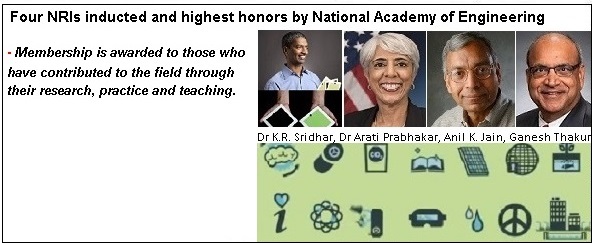| Connecting
over 25 millions NRIs worldwide |
|
|||||||||||||||||||||||
|
||
NAE Award NRIs
Posted By: nripadminon: February 12, 2016In: Top NRIPress News
FOUR NRIs inducted and highest honor by National Academy of EngineeringFour NRI Anil K. Jain, Dr Arati Prabhakar, Ganesh Thakur and Dr K.R. Sridhar (Scientists, Engineers and Professors) were selected as members of the NAE, one of the highest honors for American engineers. Membership is awarded to those who have contributed to the field through their research, practice and teaching. NRI Anil K. Jain, Professor of Computer Science & Engineering at Michigan State University: Anil K. Jain received B.Tech. degree from the Indian Institute of Technology, Kanpur, M.S., Ph.D. degrees from Ohio State University in 1973, and now is a University Distinguished Professor in the Department of Computer Science & Engineering at Michigan State University. Anil writes articles on biometrics and have appeared in IEEE Spectrum, Comm. ACM, IEEE Computer1,2, Proc. IEEE1,2, Encarta, Scholarpedia, PNAS, Scientific American and MIT Technology Review. He was interviewed by CNN, Voice of America, BBC, Bloomberg TV, Science Daily, Phys.org, New Scientist,The Times of India, Economic Times, Popular Science, Nova, Ars Technica andThe New York Times. Patents: In 1999, he has been assigned six U.S. patents on fingerprint recognition (transferred to IBM ) and two Korean patents on surveillance. He has also licensed technologies to Safran Morpho and NEC Corp., world’s leading biometric companies, that deal with law enforcement and homeland security applications, Anil Jain has been assigned six U.S. patents on fingerprint recognition (transferred to IBM in 1999) and two Korean patents on surveillance. He has also licensed technologies to Safran Morpho and NEC Corp., world’s leading biometric companies, that deal with law enforcement and homeland security applications, including (i) TattooID, a system for matching tattoo images (2012), (ii) AltFingID, a system for detecting whether a fingerprint image has been altered (2013), (iii) FaceSketchID, a system for matching facial sketches to mugshot images (2014), and (iv) FaceSearch at Scale (2015). He has collaborated with a large number of companies on computer vision and biometrics related projects, including Du Pont, Eaton Innovation Center, Ford Research Lab, General Motors Tech Center, Google ATAP, IBM Research (Almaden and Yorktown), Microsoft, NEC Research, Philips Research, Cogent, Lumidigm, Visa, Samsung, and Siemens Research. He was a consultant to India’s Aadhaar program that provides a 12-digit unique ID number to Indian residents based on their fingerprint and iris data. Author of several books: Introduction to Biometrics (2011), Handbook of Biometrics (2007), Handbook of Multibiometrics (2006), Handbook of Face Recognition (first edition: 2005; second edition 2011), Handbook of Fingerprint Recognition (first edition: 2003, second edition: 2009) (received the PSP award fromthe Association of American Publishers), Markov Random Fields: Theory and Applications (1993), and Algorithms For Clustering Data (1988). ISI has designated him as a highly cited researcher. According to CiteSeer, his book, Algorithms for Clustering Data (Prentice Hall, 1988) is ranked # 79 in the Most Cited Articles in Computer Science (over all times). Awards: Anil received Guggenheim fellowship, Humboldt Research award, Fulbright fellowship, IEEE Computer Society Technical Achievement award, IEEE W. Wallace McDowell award, IAPR King-Sun Fu Prize, IEEE ICDM Research Contribution Award, IAPR Senior Biometric Investigator Award, and the MSU Withrow Teaching Excellence Award for contributions to pattern recognition and biometrics. He also received the best paper awards from the IEEE Trans. Neural Networks (1996) and the Pattern Recognition journal (1987, 1991 and 2005). He served as the Editor-in-Chief of the IEEE Trans. Pattern Analysis and Machine Intelligence (1991-1994). He is a Fellow of the ACM, IEEE, AAAS, IAPR and SPIE. He has been listed among the “18 Indian Minds Who are Doing Cutting Edge Work” in the fields of science and technology, and felicitated with the MSU 2014 Innovator of the Year Award. • Anil served as a member of the National Academies panels on Information Technology, Whither Biometrics and Improvised Explosive Devices (IED). ——– Dr. Prabhakar received her Doctor of Philosophy in applied physics and Master of Science in electrical engineering from the California Institute of Technology. She received her Bachelor of Science in electrical engineering from Texas Tech University. She began her career as a Congressional Fellow at the Office of Technology Assessment. —————————– NRI Dr. Ganesh Thakur received B.S. degree with first rank in petroleum engineering from Indian School of Mines and M.S. and Ph.D. degrees in petroleum and natural gas engineering plus an M.A. degree in mathematics from Pennsylvania State University. He earned an executive MBA degree from Houston Baptist University. • He is an established leader in the interdisciplinary practice of waterflood management He has served as an adjunct professor at USC, University of Texas (Permian Basin), University of Houston, Houston Baptist University, and King Saud University in Riyadh, Saudi Arabia. ——————————- • Sridhar led a project that built a Mars oxygen production cell The Bloom fuel cells are expected to not only increase our efficiency and lessen our environmental impact (approximately 49 percent less CO2 emissions than our first-phase data center), but also boost the performance of our commerce platforms by reducing the risk of outages. In this way, we’re seeing proof that environmental considerations go hand-in-hand with good business strategy. Sridhar spent most of the ’90s developing fuel cells. • In 2010, Bloom Energy launched a new energy-efficient and environmentally friendly fuel cell known as the Bloom Box. A natural gas and atmospheric oxygen are pumped through a stack of cells, producing electricity, but theoretically any other gaseous fuel could be used. Dr. KR Sridhar was Director of the Space Technologies Laboratory (STL) at the University of Arizona where he was also a professor of Aerospace and Mechanical Engineering.
|
||
| |
|
|

